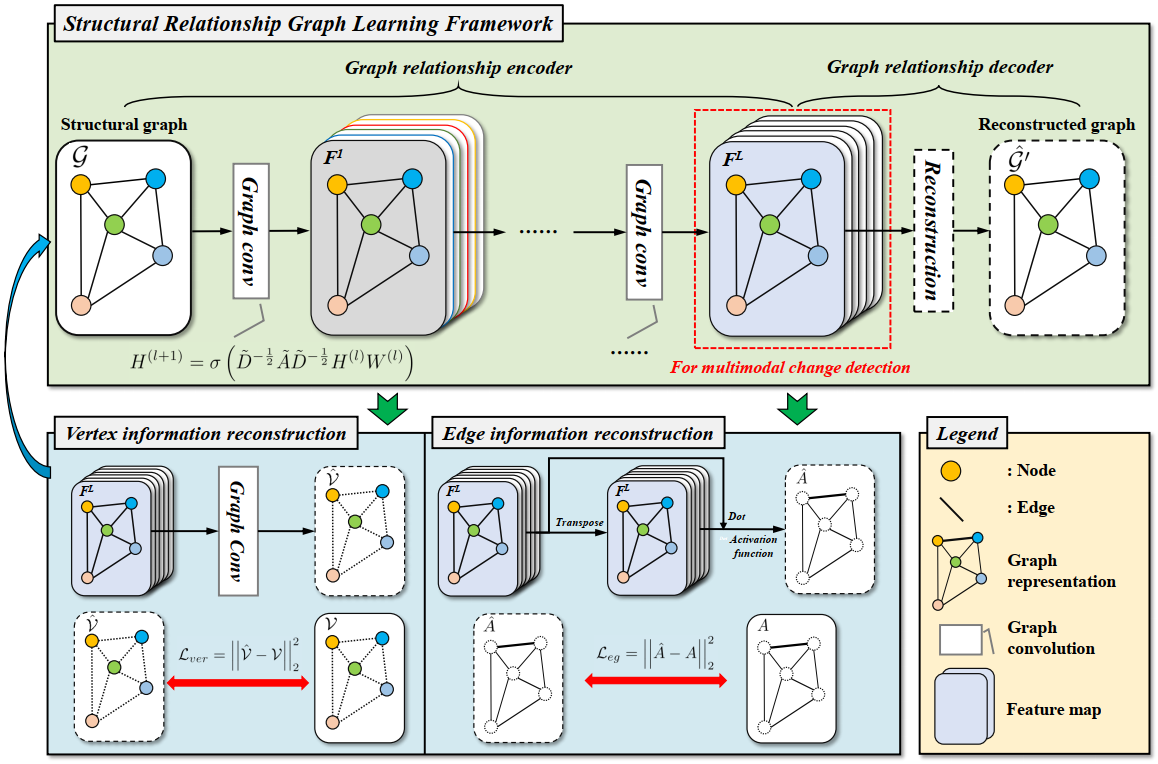Unsupervised Multimodal Change Detection Based on Structural Relationship Graph Representation Learning
Hongruixuan Chen, Naoto Yokoya, Chen Wu, and Bo Du
This is an official implementation of unsupervised multimodal change detection framework SR-GCAE in our IEEE TGRS 2022 paper: Unsupervised Multimodal Change Detection Based on Structural Relationship Graph Representation Learning.
Unsupervised multimodal change detection is a practical and challenging topic that can play an important role in time-sensitive emergency applications. To address the challenge that multimodal remote sensing images cannot be directly compared due to their modal heterogeneity, we take advantage of two types of modality-independent structural relationships in multimodal images. In particular, we present a structural relationship graph representation learning framework for measuring the similarity of the two structural relationships. Firstly, structural graphs are generated from preprocessed multimodal image pairs by means of an object-based image analysis approach. Then, a structural relationship graph convolutional autoencoder (SR-GCAE) is proposed to learn robust and representative features from graphs. Two loss functions aiming at reconstructing vertex information and edge information are presented to make the learned representations applicable for structural relationship similarity measurement. Subsequently, the similarity levels of two structural relationships are calculated from learned graph representations and two difference images are generated based on the similarity levels. After obtaining the difference images, an adaptive fusion strategy is presented to fuse the two difference images. Finally, a morphological filtering-based postprocessing approach is employed to refine the detection results. Experimental results on six datasets with different modal combinations demonstrate the effectiveness of the proposed method.
python==3.9.7
pytorch==1.9.0
scikit-learn==0.18.3
imageio=2.9.0
numpy==1.20.3
gdal==3.0.2
opencv==4.5.5
This repo contains the Shuguang dataset. The homogeneous dataset, Hanyang dataset has been open-sourced. You can download it here. The Texas dataset can be downloaded from Prof. Michele Volpi's webpage.
Performing edge information reconstruction and detecting land-cover changes by utilizing local structural relationship
train_SRGCAE_Local.py
Performing vertex information reconstruction and detecting land-cover changes by utilizing nonlocal structural relationship
train_SRGCAE_Nonlocal.py
Adaptively fusing the difference maps
adaptive_fuse.py
Postprocessing based on morphological filtering
aux_func/postprocess.py
If this code or dataset contributes to your research, please consider citing our paper. We appreciate your support!🙂
@article{chen2022unsupervised,
author={Chen, Hongruixuan and Yokoya, Naoto and Wu, Chen and Du, Bo},
journal={IEEE Transactions on Geoscience and Remote Sensing},
title={Unsupervised Multimodal Change Detection Based on Structural Relationship Graph Representation Learning},
year={2022},
volume={60},
number={},
pages={1-18},
doi={10.1109/TGRS.2022.3229027}
}
The Python code draws in part on the Matlab code of NPSG and IRGMcS. Many thanks for these brilliant works!
For any questions, please contact us.
